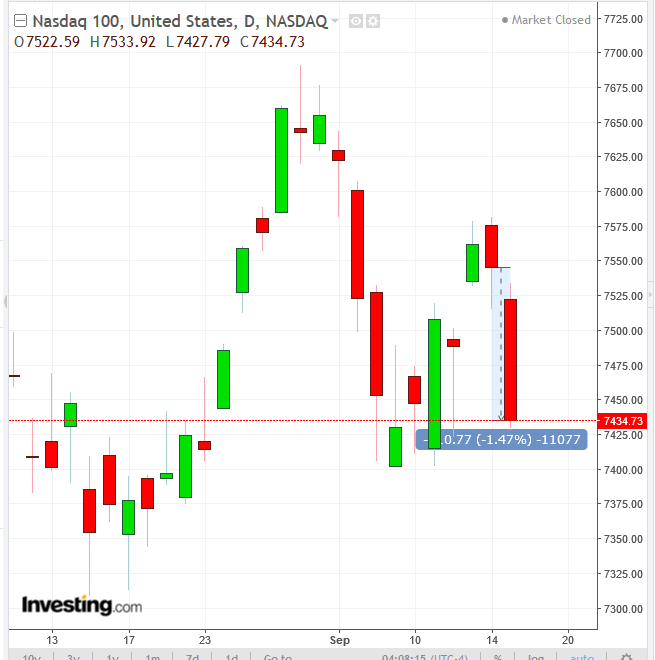- China stocks outperform, yuan rebounds
- Dow outperforms, despite sensitivity to trade war
- Oil sold off on lower demand outlook, result of trade dispute
- South Korean President Moon Jae-in visits Pyongyang for a summit with Kim Jong Un Tuesday.
- Japanese trade flow numbers are due early Wednesday in Tokyo.
- The Bank of Japan holds its policy meeting on Wednesday.
- Britain releases inflation data on Wednesday
- Eurozone PMI is due on Friday
- The Organization of Petroleum Exporting Countries (OPEC) and its allies meet in Algiers this coming weekend.
- The Stoxx Europe 600 Index gained 0.3 percent, the highest in two weeks.
- Futures on the S&P 500 Index climbed 0.1 percent.
- The U.K.’s FTSE 100 rose less than 0.05 percent.
- Germany’s DAX gained 0.7 percent.
- The MSCI Emerging Markets Index fell 1.18 percent.
- The MSCI Asia Pacific slid 0.64 percent.
- The Dollar Index fell less than 0.10 percent.
- The euro climbed less than 0.05 percent to $1.1687.
- The British pound dipped 0.1 percent to $1.3142.
- The Japanese yen declined 0.1 percent to 112.00 per dollar.
- The yield on 10-year Treasuries increased one basis point to 3.00 percent, the highest in almost seven weeks.
- Germany’s 10-year yield decreased one basis point to 0.45 percent.
- Britain’s 10-year yield was unchanged at 1.536 percent, the highest in more than four months.
- Italy's 10-year yield gained four basis points to 2.883 percent, the most significant advance in more than a week.
- West Texas Intermediate crude fell 0.3 percent to $68.71 a barrel.
- Gold decreased 0.3 percent to $1,197.46 an ounce.
Key Events
Even after US President Donald Trump officially confirmed he'd be imposing an additional round of tariffs on another $200 billion in Chinese goods, and China signaled that it planned to retaliate the pan-European STOXX 600 jumped at the open this morning, rising about 0.30 percent, and is currently trading at the height of its session. Futures for the S&P 500, NASDAQ 100 and Dow are also pointing higher.
Earlier today, during the Asian session, even China’s Shanghai Composite leaped 1.82 percent, bouncing from a 4-year low and providing the best gains in the region. An explanation for this surprising bullishness, amidst a clear escalation of the US-Sino trade war—the single most significant headwind for equities since March—is investor perspective which appears to have been watered down over the duration.
Since the spat first developed, investors may have already anticipated all this tit-for-tat activity and could have even already priced-in the expanded event.

The same argument may be applied to the Chinese yuan’s bounce off its daily lows.
Hong Kong’s Hang Seng didn't fare as well, rising just 0.59%. Still, along with the regional trade headwinds, Hong Kong is contending with the cleanup for Typhoon Manghut, responsible for over $29.1 million in damages.
What’s astonishing is that the equity benchmark for the target of the latest $200 billion round of fresh levies, China, outperformed the region. One theory could be that Trump announced 10 percent tariffs, rising to 25 percent only in January, which could give the two nations time to dial back the hostilities via negotiation.
Global Financial Affairs
Yesterday, stocks in the US fell hard, as traders took profit while bracing for the trade dispute acceleration.
The S&P 500 dropped 0.56 percent, capping a five-day straight gain, with technology firms, such as Amazon (NASDAQ:AMZN), Apple (NASDAQ:AAPL), and Microsoft (NASDAQ:MSFT) dragging the broader market lower. Investors rotated into Consumer Staples such as Procter & Gamble (NYSE:PG) and Energy stocks, such as Exxon Mobil (NYSE:XOM).
The Dow Jones Industrial Average fell 0.35 percent, outperforming its US peers. This would suggest that US traders are not as concerned about a trade war as many believe.

The NASDAQ plunged, dropping 1.43 percent. The NASDAQ 100 underperformed, sinking 1.47 percent, its most significant drop since June.
The Russell 2000 fell 1.06 percent.
Yesterday’s reversal may accentuate the turning point for sentiment in this market. Though the indices do eventually go higher, investors have increased the level of dip-buying that followed earlier tariff announcements. The question investors need to ask themselves going forward is whether traders have included, and therefore discounted, China’s retaliatory rhetoric.

In FX markets, the dollar rebounded from an earlier fall, almost completely wiping out any of today's losses. The pattern formed a mighty bullish hammer above the 94.40 level, which has shown to be supported since August 28. Still, the price is below the uptrend line since May 14.
The Aussie dollar also recovered, from losses driven by trade concerns. China is Australia's biggest trading partner, which means any negative impact on China's economy will have direct effects on Australia as well. The AUD/USD bounce followed the country's confirmation that its next move will likely be an interest rate hike, even as it warned of the potential negative impact of the US-Sino trade war.
Oil gave up earlier gains this morning, though it's currently moving higher once again. An outlook for lowered demand as a result of the global trade war may have overshadowed international supply concerns.
Up Ahead
Market Moves
All information correct at time of writing
Stocks
Currencies
Bonds
Commodities
